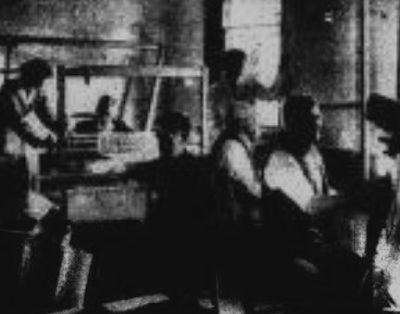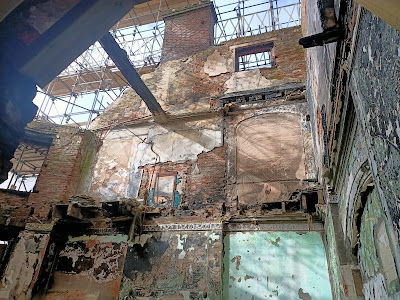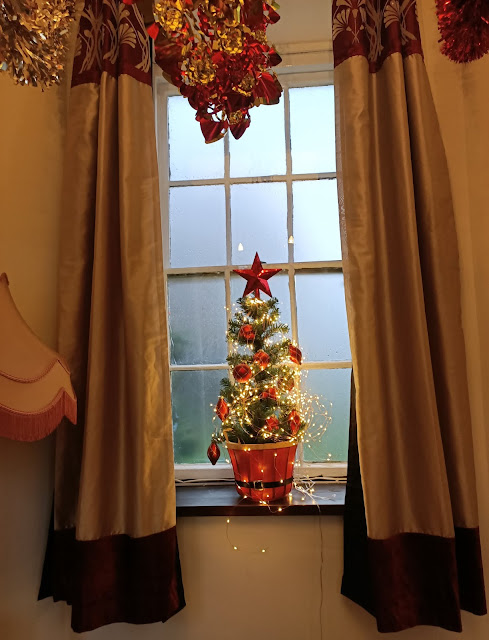The Healing Process
 |
| Our former stairwell |
Nigel and I were over to show local borough councillors, Gary and Simon White around the shell of the building as part of a question-and-answer session. We kitted them out in hard hats and hi-viz jackets and took them in to view the test window units we’ve installed, and to show them the extent of the damage inside.
 |
| This was the study, laterly the Professor and Dr Brown's bedroom |
Describing the extent of the damage to someone is one thing, experiencing it for oneself is quite another. We pointed out some of the decidedly ropey Victorian brickwork, and discussed the challenges of repairing an old house, whilst conforming to modern building and planning regulations.
Our Georgian and Victorian predecessors were unhampered by those problems! It was a really useful meeting with lots of insightful questions and advice from our councillors. Many thanks to Gary and Simon for taking time out to visit us over their weekend.
I had another delve into the British Newspaper Archive this
week, and found a fascinating article about a comparatively recent part of
Betley Court’s history that is largely unknown to many incomers to the village.
The article relates to Betley Court’s brief history as a convalescence unit for
orthopaedic cases, firstly as a Red Cross hospital in WW2, then later as part
of North Staffordshire Royal Infirmary, when it was known as Betley Court
Rehabilitation Centre. Whilst I have corresponded
with a former physio therapist, a patient, and the son of a former patient Click here to read post , we had little details about how the unit was set out, or what went on in the
house, outbuildings and gardens.
 |
| A photo from the Sentinel in 1940 |
Luckily, for our research, in 1944, the Evening Sentinel sent a reporter to cover the story of, to use their words, “one of the most beautiful residencies in the area” becoming a centre for rehabilitation. The plan, was to create a rehabilitation centre to deal with injuries sustained by those employed in the North Staffordshire coal field, although it did not solely deal with miners. The staff reporter observed, “the Court is ideally situated for its present purpose, that of restoring injured men from one of the country's most vital heavy industries to full health and efficiency.” Both physio therapy and occupational therapy have become medical disciplines in their own right, but were in their infancy in the 1940s. The importance of rehabilitation to both local and national economies was clear.
To this end, Betley Court itself, was reconfigured to accommodate
40 beds, along with the necessary staff. The stable block (now a private
residence known as ‘The Clock House’) became a large gymnasium, kitted out with
apparatus ‘for giving graduated exercise’. The laundry block (demolished in the
late 1970s due to dilapidation, to provide access to the houses of Court Walk)
was adapted for occupational therapy, “which aims to use the injured limbs as
normally as possible.” Much of the equipment was paid for by, “the generosity
of North Staffordshire colliery owners” (quite right!). The reporter notes that,
“Great advances have been made
recently in physical rehabilitation, embodying special lines of treatment to
counteract the aftereffects of injury or disease. In addition, the curing of a
complaint – the setting of a fracture or performing an operation – patients are
given special treatment to keep up the tone of their muscles and to prevent
them becoming disabled and unfit.”
The psychological effects of injury were addressed too, with
the fear of becoming a permanent invalid spelling disaster for a household
wager earner. Treatments were designed to build confidence and patients were
encouraged to do things for themselves. (I’ve heard lovely stories from older
villagers about patients being sent on errands around the village to aid their
recovery).
 |
| General physical training to bring all the patients muscles to normal use. Taking place in the stable courtyard. |
The reporter was shown physio sessions taking place in the gym. First, he witnessed patients undertaking exercise in the stable yard, then inside patients with leg injuries were taking part in ‘quadriceps drills’ – contracting the thighs by means of weights attached to pulleys.
Inside the occupational therapy room, there was a good range
of handicraft equipment which included weaving looms, rugmaking kit, painting
supplies and leatherworking tools. The reporter noted,
“Occupational therapy is very valuable because it provides mental diversion and at the same time, gives opportunity for repeated exercises…Men with stiff fingers and arms were operating shuttles and working needles, and every movement means working muscles, which by constant repetition of the movement regain their former mobility.”
 |
| Weaving and other activities, taking place under the watchful eye of Miss A Turner and Mrs C Emmett |
The article brought Betley Court Rehabilitation Centre alive
to me. I’m pleased we found some answers to questions we’ve wondered about. Of
course, our biggest rehabilitation task is now on the Betley Court itself, to
fix it after its terrible accident. That’s just going to take time, expertise and
a lot of money.
All best wishes
Ladybird Su
All quotes taken from:
Evening Sentinel, 1/9/44, p5, “Rehabilitation Centre For The
Workers”, accessed from Remedial
Work At Bet | Staffordshire Sentinel | Friday 01 September 1944 | British
Newspaper Archive
The British Newspaper Archive is a huge collection of
newspaper articles from Britain and Ireland, and available online for researchers
and nosey-parkers like me! It can be viewed at:British Newspaper Archive





Great picture of Nigel. Spring at Betley Court brings back memories of April 1978 and later.
ReplyDeleteNorm Overly, Indiana
Nice to hear from you, Norm, (and Jean too) all the way in Indiana. Well, I expect the climate is a little different in Indiana to the English Midlands. We're experiencing an extremely wet February. Betley Court has changed a little since 1978.! All best wishes Su & Nigel
Delete